Effects of Epoxy Resin Value on Waterborne-Epoxy-Resin-Modified Emulsified Asphalt Mixture Performance
Abstract
:1. Introduction
1.1. Research Background
1.2. Research Scope
1.3. Preliminary Research
1.4. Research Purpose
2. Methodology
2.1. Materials
2.1.1. Asphalt Matrix
2.1.2. WER and Curing Agents
2.1.3. Aggregates
2.2. Mix Design
2.2.1. Asphalt Mixture Grading
2.2.2. Determination of Optimal Water Consumption
2.2.3. Determination of the Optimal Amount of Asphalt
2.3. Mixture Preparation Process
2.3.1. Mixing Procedure
2.3.2. Molding Method
2.3.3. Marshall Specimen Health Conditions
2.4. Mixture Performance Testing Methods
2.4.1. High-Temperature Performance Tests
2.4.2. Low-Temperature Performance Tests
2.4.3. Asphalt Mixture Water Stability Performance Test
3. Results and Discussion
3.1. High-Temperature Performance
3.1.1. Marshall Stability Test
3.1.2. Rutting Test
3.2. Low-Temperature Performance
3.3. Water Stability Performance
3.3.1. Immersion Marshall Test
3.3.2. Freeze–Thaw Splitting Test
4. Conclusions and Recommendations
- (1)
- In the mix design, the water consumption of the selected additive was 3–3.5%, and the optimal emulsion dosage of the four mixtures was 9%. It was verified that the volume indexes of the Marshall specimens of the EA, E20-T, E44-T, and E51-T mixtures prepared according to the gradation in this paper met the requirements of the specification.
- (2)
- The three WER systems can significantly improve the high-temperature performance and water stability of emulsified asphalt mixtures. This is because after the WER system is cured, a dense three-dimensional skeleton structure is generated in the mixture, which can tightly wrap the asphalt so that its fluidity will not change too much even at a high temperature or in the presence of water pressure, thus forming a high-performance whole with the mixture.
- (3)
- In terms of high-temperature performance, the E20-T mixture was better than the other two WER-EA mixtures, showing the highest MS value, T value, and DS value, and the smallest FL value and RD value. This is consistent with the conclusions of the asphalt performance analysis, which indicated that WER with a low epoxy value is more conducive to improving the high-temperature deformation resistance of WER-EA mixtures.
- (4)
- In terms of low-temperature performance, the RT value and value of the E44-T mixture were larger than those of the other mixtures, while its ST value was the smallest. The performance of the E20-T mixture was opposite to that of the E44-T mixture, that is, E44 had the least negative impact on the low-temperature performance of the WER-EA mixture, while E20 caused the greatest weakening of the low-temperature crack resistance of the WER-EA mixture. This indicates that WER with a medium epoxy value can reduce the low-temperature performance of WER-EA mixtures.
- (5)
- The TSR value and IRS value of the E20-T mixture were higher, that is, the comprehensive effect of E20-T on improving the water damage resistance of the emulsified asphalt mixture was better. This is because the use of WER with a low epoxy value is more conducive to the formation of a more stable and cross-linked interpenetrating polymer network in a WER-EA mixture.
Author Contributions
Funding
Institutional Review Board Statement
Informed Consent Statement
Data Availability Statement
Acknowledgments
Conflicts of Interest
Abbreviations
| AC | Asphalt concrete |
| BBR | Bending Beam Rheometer |
| DETA | Diethylenetriamine |
| DS | Dynamic stability |
| DSR | Dynamic Shear Rheometer |
| EA | Emulsified asphalt |
| FL | Flow value |
| FTIR | Fourier Transform Infrared Spectroscopy |
| IRS | Index of retained strength |
| MS | Marshall stability |
| OAC | Optimal asphalt content |
| RD | Rutting depth |
| RT | Relevant indexes of splitting tensile strength |
| SBR | Styrene-butadiene rubber |
| SBS | Styrene-butadiene-styrene |
| SEM | Scanning Electron Microscopy |
| ST | Failure stiffness modulus at tensile test |
| TETA | Triethylenetetramine |
| TSR | Tensile strength ratio |
| VFA | Voids filled with asphalt |
| VMA | Voids in mineral aggregates |
| VV | Volume of void space |
| WER | Waterborne epoxy resin |
| AASHTO | The American Association of State Highway and Transportation Officials |
References
- Qiao, Y.; Dawson, A.R.; Parry, T.; Flintsch, G.; Wang, W. Flexible Pavements and Climate Change: A Comprehensive Review and Implications. Sustainability 2020, 12, 1057. [Google Scholar] [CrossRef]
- Pereira, P.; Pais, J. Main Flexible Pavement and Mix Design Methods in Europe and Challenges for the Development of an European Method. J. Traffic Transp. Eng. Engl. Ed. 2017, 4, 316–346. [Google Scholar] [CrossRef]
- Maadani, O.; Shafiee, M.; Egorov, I. Climate Change Challenges for Flexible Pavement in Canada: An Overview. J. Cold Reg. Eng. 2021, 35, 03121002. [Google Scholar] [CrossRef]
- Wei, Y.-M.; Chen, K.; Kang, J.-N.; Chen, W.; Wang, X.-Y.; Zhang, X. Policy and Management of Carbon Peaking and Carbon Neutrality: A Literature Review. Engineering 2022, 14, 52–63. [Google Scholar] [CrossRef]
- Chen, L.; Msigwa, G.; Yang, M.; Osman, A.I.; Fawzy, S.; Rooney, D.W.; Yap, P.-S. Strategies to Achieve a Carbon Neutral Society: A Review. Env. Chem. Lett. 2022, 20, 2277–2310. [Google Scholar] [CrossRef] [PubMed]
- Dawson, A. Anticipating and Responding to Pavement Performance as Climate Changes. In Climate Change, Energy, Sustainability and Pavements; Green Energy and Technology; Gopalakrishnan, K., Steyn, W.J., Harvey, J., Eds.; Springer: Berlin/Heidelberg, Germany, 2014; pp. 127–157. ISBN 978-3-662-44718-5. [Google Scholar]
- Almeida, A.; Picado-Santos, L. Asphalt Road Pavements to Address Climate Change Challenges—An Overview. Appl. Sci. 2022, 12, 12515. [Google Scholar] [CrossRef]
- Meng, Y.; Chen, J.; Kong, W.; Hu, Y. Review of Emulsified Asphalt Modification Mechanisms and Performance Influencing Factors. J. Road Eng. 2023, 3, 141–155. [Google Scholar] [CrossRef]
- Jiang, S.; Li, J.; Zhang, Z.; Wu, H.; Liu, G. Factors Influencing the Performance of Cement Emulsified Asphalt Mortar—A Review. Constr. Build. Mater. 2021, 279, 122479. [Google Scholar] [CrossRef]
- Wada, Y.; Izaiku, H.; Koike, M. Studies on Asphalt Emulsion.I. J. Jpn. Oil Chem. Soc. 1967, 16, 23–29. [Google Scholar] [CrossRef]
- Umar, H.A.; Zeng, X.; Lan, X.; Zhu, H.; Li, Y.; Zhao, H.; Liu, H. A Review on Cement Asphalt Emulsion Mortar Composites, Structural Development, and Performance. Materials 2021, 14, 3422. [Google Scholar] [CrossRef]
- Jain, S.; Singh, B. Cold Mix Asphalt: An Overview. J. Clean. Prod. 2021, 280, 124378. [Google Scholar] [CrossRef]
- Liu, B.; Liang, D. Influence of SBS and SBR on the Properties of Emulsified Asphalt. Pet. Sci. Technol. 2017, 35, 1008–1013. [Google Scholar] [CrossRef]
- Zhou, Q.; Ling, T.; Hao, Z.; Wu, X.; Li, L.; Xu, G. Feature Analysis of Waterborne Epoxy Resin-Emulsified Asphalt Blend. J. Build. Mater. 2018, 21, 414–419. [Google Scholar] [CrossRef]
- Zhang, L.; Shu, W. Development and Progress of Waterborne Epoxy Resin System. Paint Coat. Ind. 2002, 32, 28–30. [Google Scholar]
- Yang, G.; Wang, C.; Fu, H.; Yan, Z.; Yin, W. Waterborne Epoxy Resin–Polyurethane–Emulsified Asphalt: Preparation and Properties. J. Mater. Civ. Eng. 2019, 31, 04019265. [Google Scholar] [CrossRef]
- Liu, F.; Zheng, M.; Liu, X.; Ding, X.; Wang, F.; Wang, Q. Performance Evaluation of Waterborne Epoxy Resin-SBR Composite Modified Emulsified Asphalt Fog Seal. Constr. Build. Mater. 2021, 301, 124106. [Google Scholar] [CrossRef]
- Li, R.; Leng, Z.; Zhang, Y.; Ma, X. Preparation and Characterization of Waterborne Epoxy Modified Bitumen Emulsion as a Potential High-Performance Cold Binder. J. Clean. Prod. 2019, 235, 1265–1275. [Google Scholar] [CrossRef]
- Kezhen, Y.; Junyi, S.; Kaixin, S.; Min, W.; Goukai, L.; Zhe, H. Effects of the Chemical Structure of Curing Agents on Rheological Properties and Microstructure of WER Emulsified Asphalt. Constr. Build. Mater. 2022, 347, 128531. [Google Scholar] [CrossRef]
- ASTM D5; Test Method for Penetration of Bituminous Materials. ASTM International: West Conshohocken, PA, USA, 2020.
- ASTM D113; Test Method for Ductility of Asphalt Materials. ASTM International: West Conshohocken, PA, USA, 2017.
- ASTM D36; Test Method for Softening Point of Bitumen (Ring-and-Ball Apparatus). ASTM International: West Conshohocken, PA, USA, 2020.
- ASTM D4402; Test Method for Viscosity Determination of Asphalt at Elevated Temperatures Using a Rotational Viscometer. ASTM International: West Conshohocken, PA, USA, 2023.
- ASTM D7402; Practice for Identifying Cationic Emulsified Asphalts. ASTM International: West Conshohocken, PA, USA, 2017.
- ASTM D244; Standard Test Methods and Practices for Emulsified Asphalts. ASTM International: West Conshohocken, PA, USA, 2020.
- ASTM D6933; Test Method for Oversized Particles in Emulsified Asphalts (Sieve Test). ASTM International: West Conshohocken, PA, USA, 2022.
- ASTM D6934; Test Method for Residue by Evaporation of Emulsified Asphalt. ASTM International: West Conshohocken, PA, USA, 2022.
- ASTM D6930; Test Method for Settlement and Storage Stability of Emulsified Asphalts. ASTM International: West Conshohocken, PA, USA, 2019.
- ASTM C131; Test Method for Resistance to Degradation of Small-Size Coarse Aggregate by Abrasion and Impact in the Los Angeles Machine. ASTM International: West Conshohocken, PA, USA, 2020.
- ASTM C136; Test Method for Sieve Analysis of Fine and Coarse Aggregates. ASTM International: West Conshohocken, PA, USA, 2019.
- ASTM C88; Test Method for Soundness of Aggregates by Use of Sodium Sulfate or Magnesium Sulfate. ASTM International: West Conshohocken, PA, USA, 2018.
- ASTM C142; Test Method for Clay Lumps and Friable Particles in Aggregates. ASTM International: West Conshohocken, PA, USA, 2017.
- ASTM D4791; Test Method for Flat Particles, Elongated Particles, or Flat and Elongated Particles in Coarse Aggregate. ASTM International: West Conshohocken, PA, USA, 2019.
- ASTM C117; Test Method for Materials Finer than 75-Um (No. 200) Sieve in Mineral Aggregates by Washing. ASTM International: West Conshohocken, PA, USA, 2023.
- ASTM C128; Test Method for Relative Density (Specific Gravity) and Absorption of Fine Aggregate. ASTM International: West Conshohocken, PA, USA, 2022.
- ASTM D2419; Test Method for Sand Equivalent Value of Soils and Fine Aggregate. ASTM International: West Conshohocken, PA, USA, 2022.
- ASTM D854; Test Methods for Specific Gravity of Soil Solids by Water Pycnometer. ASTM International: West Conshohocken, PA, USA, 2023.
- ASTM D2216; Test Methods for Laboratory Determination of Water (Moisture) Content of Soil and Rock by Mass. ASTM International: West Conshohocken, PA, USA, 2019.
- ASTM D4318; Test Methods for Liquid Limit, Plastic Limit, and Plasticity Index of Soils. ASTM International: West Conshohocken, PA, USA, 2017.
- AASHTO M 323; Standard Specification for Superpave Volumetric Mix Design. American Association of State Highway and Transportation Officials (AASHTO): Washington, DC, USA, 2017.
- AASHTO T 324; Standard Method of Test for Hamburg Wheel-Track Testing of Compacted Asphalt Mixtures. American Association of State Highway and Transportation Officials (AASHTO): Washington, DC, USA, 2019.
- ASTM D6927; Test Method for Marshall Stability and Flow of Asphalt Mixtures. ASTM International: West Conshohocken, PA, USA, 2022.
- ASTM D2041; Test Method for Theoretical Maximum Specific Gravity and Density of Bituminous Paving Mixtures. ASTM International: West Conshohocken, PA, USA, 2019.
- ASTM D6931; Standard Test Method for Indirect Tensile (IDT) Strength of Asphalt Mixtures. ASTM International: West Conshohocken, PA, USA, 2017.
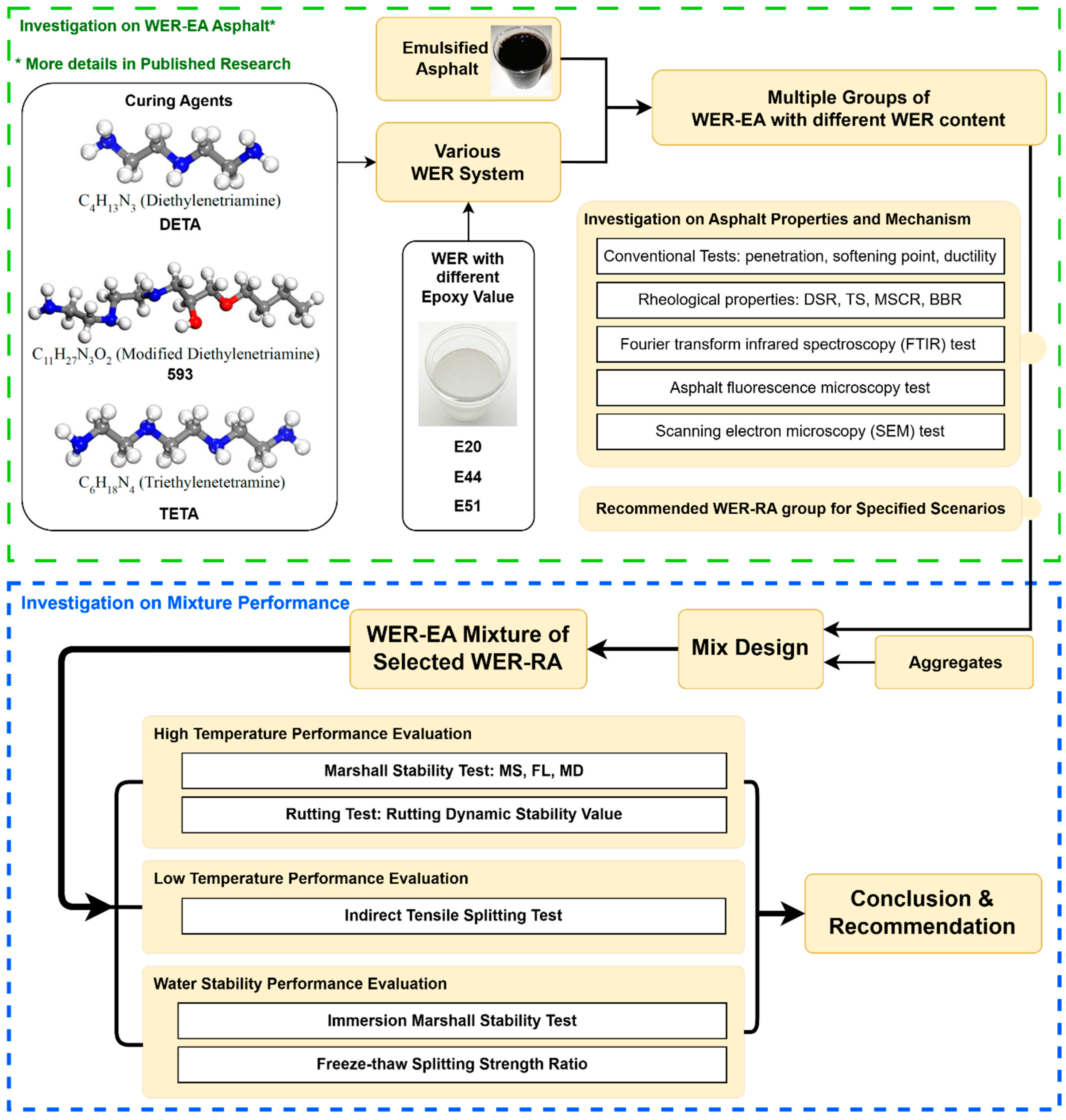
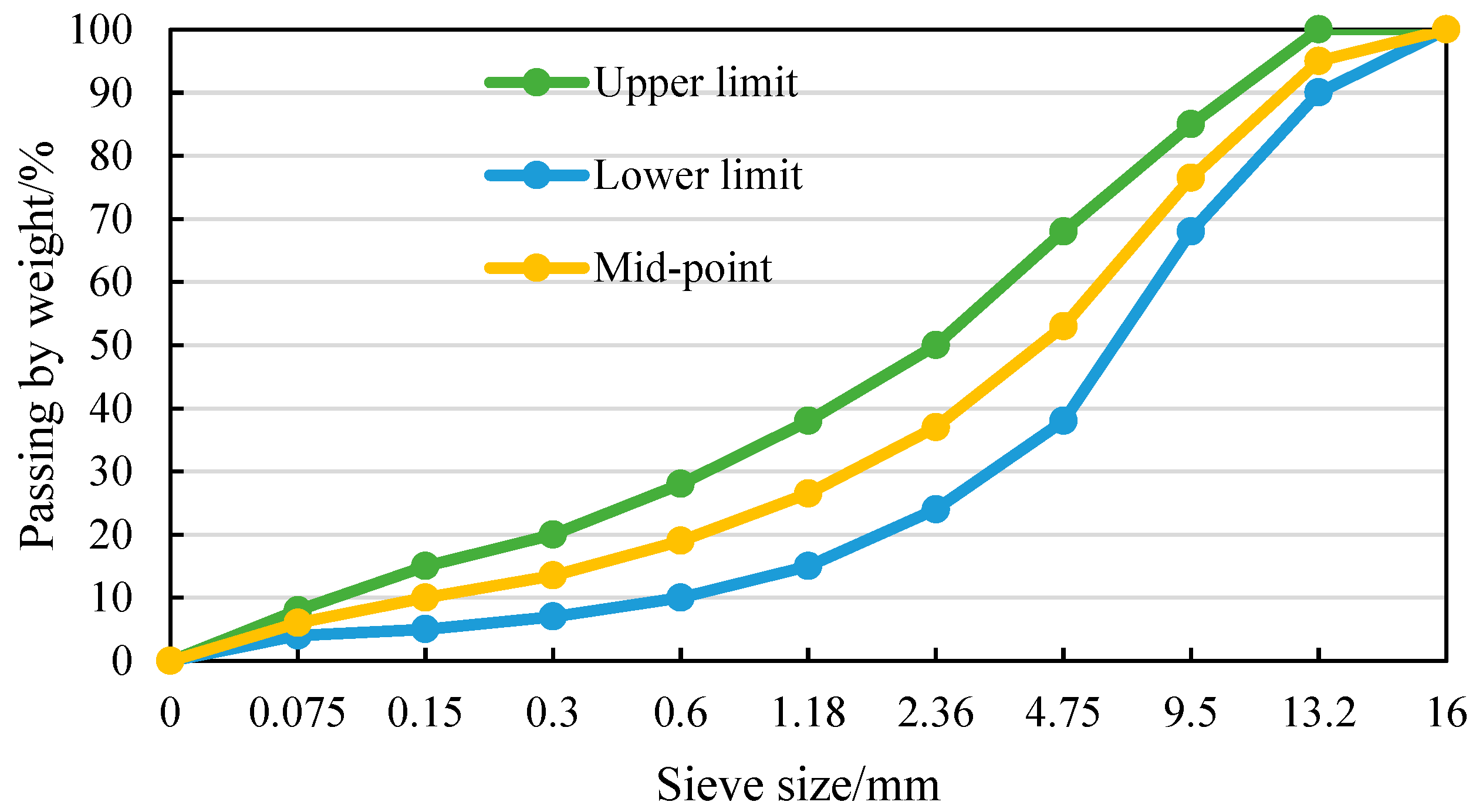
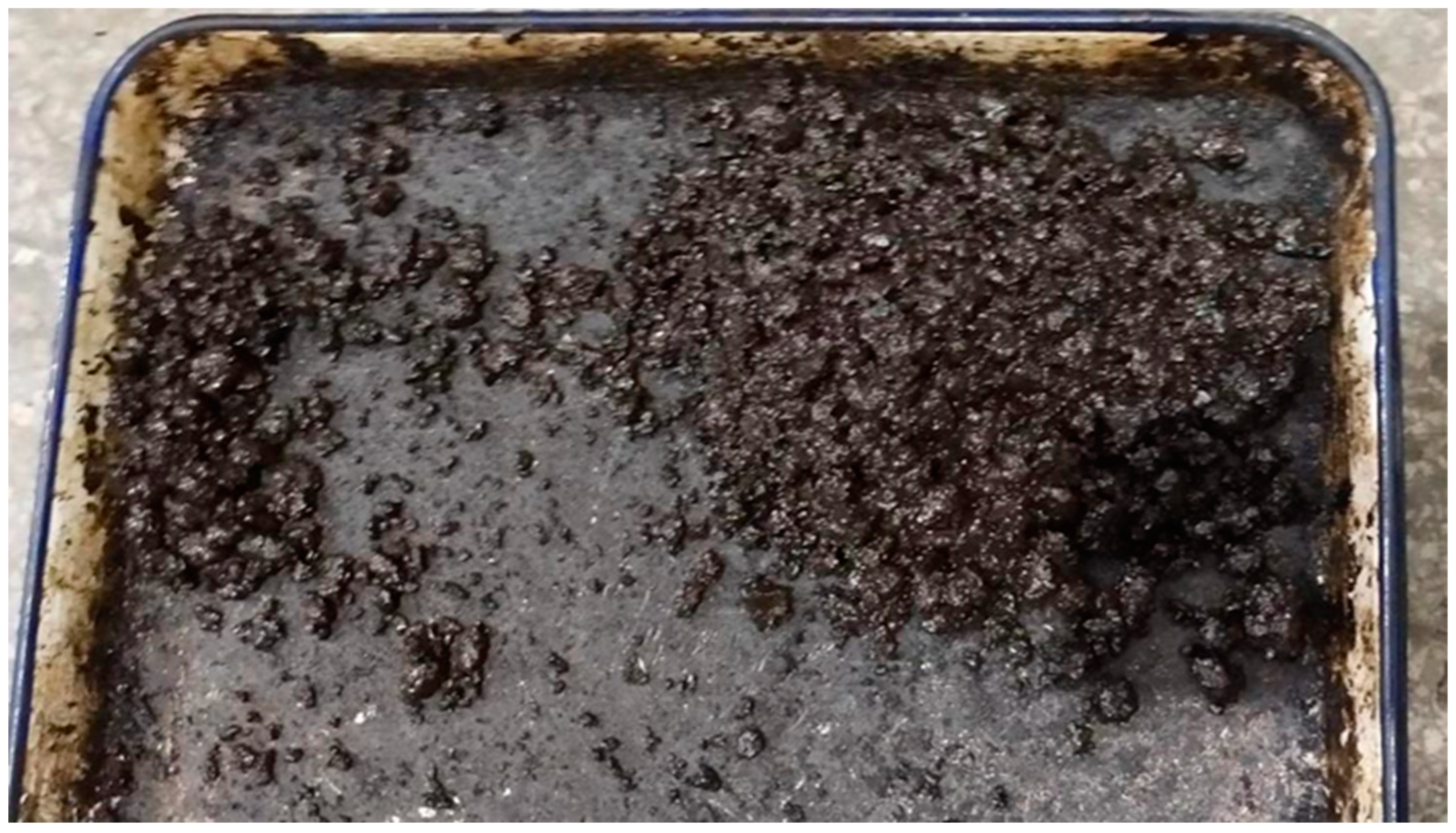
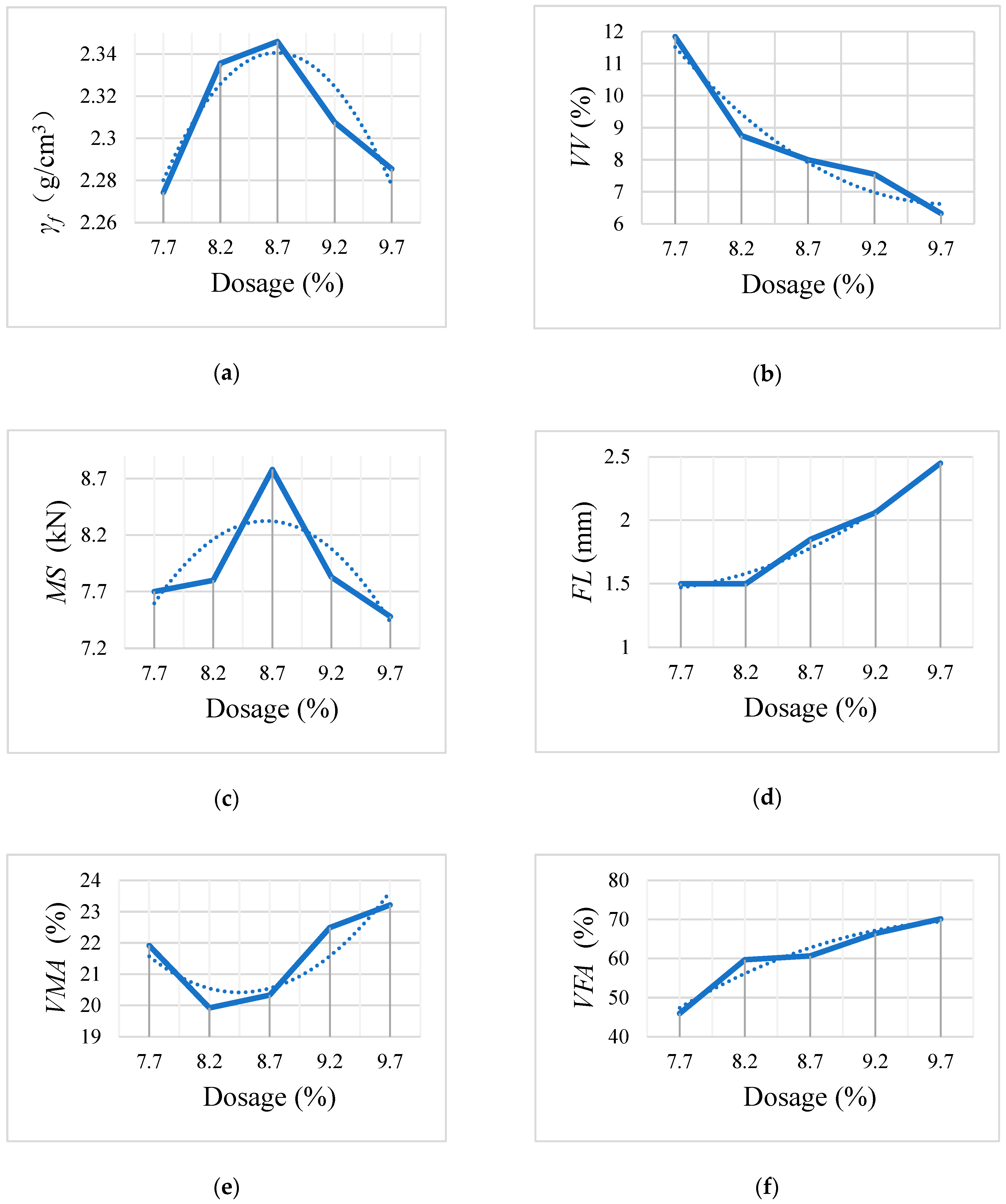
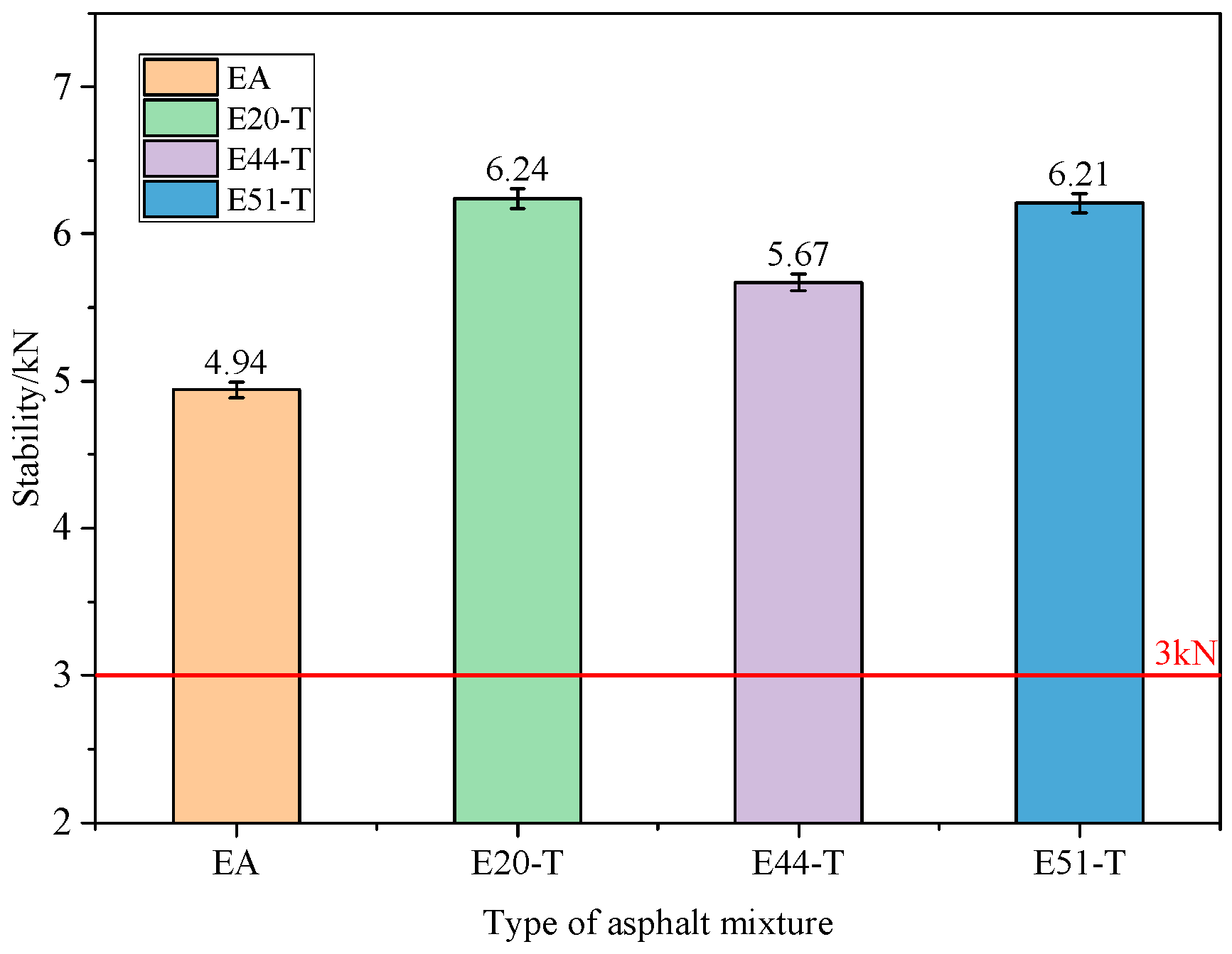
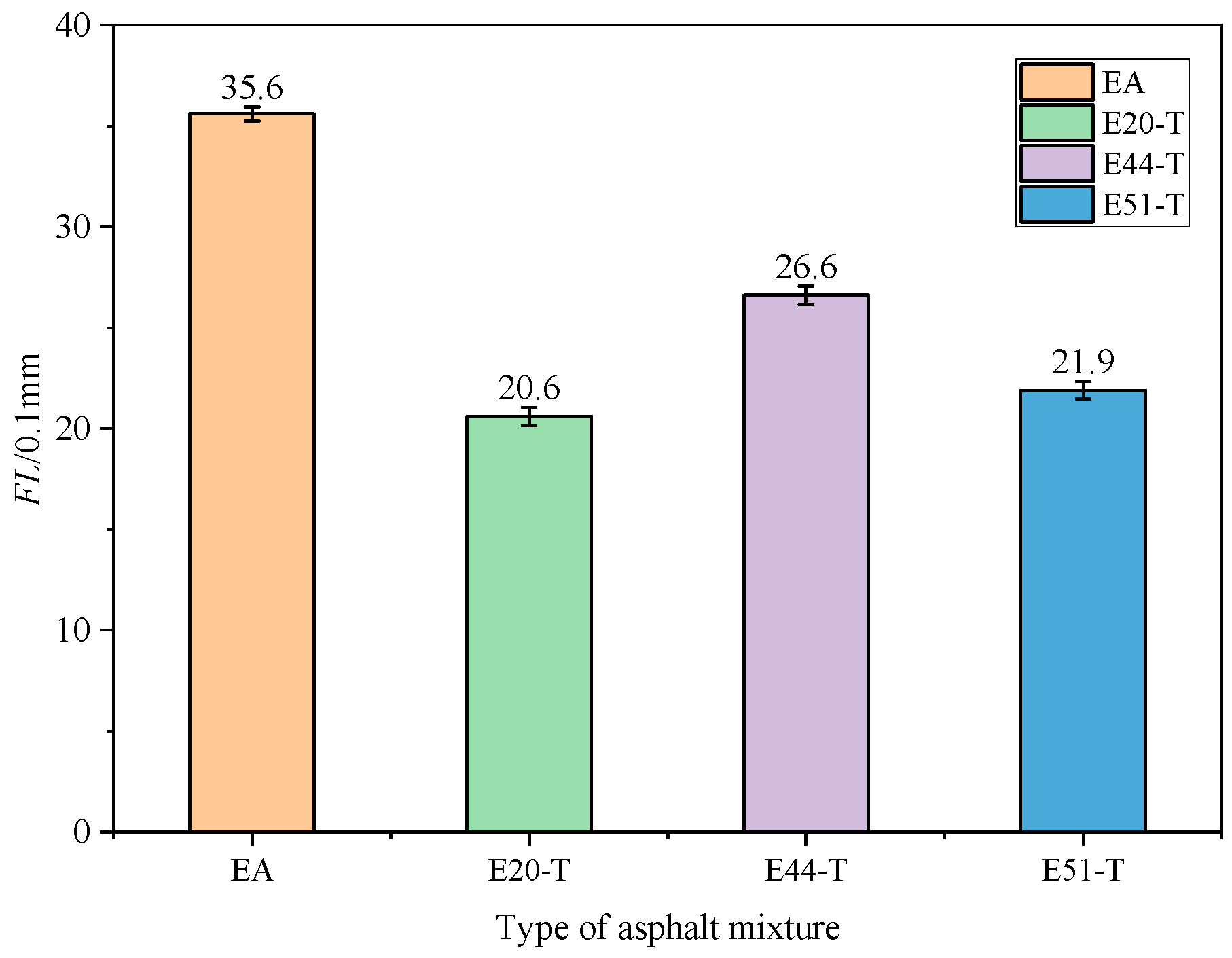
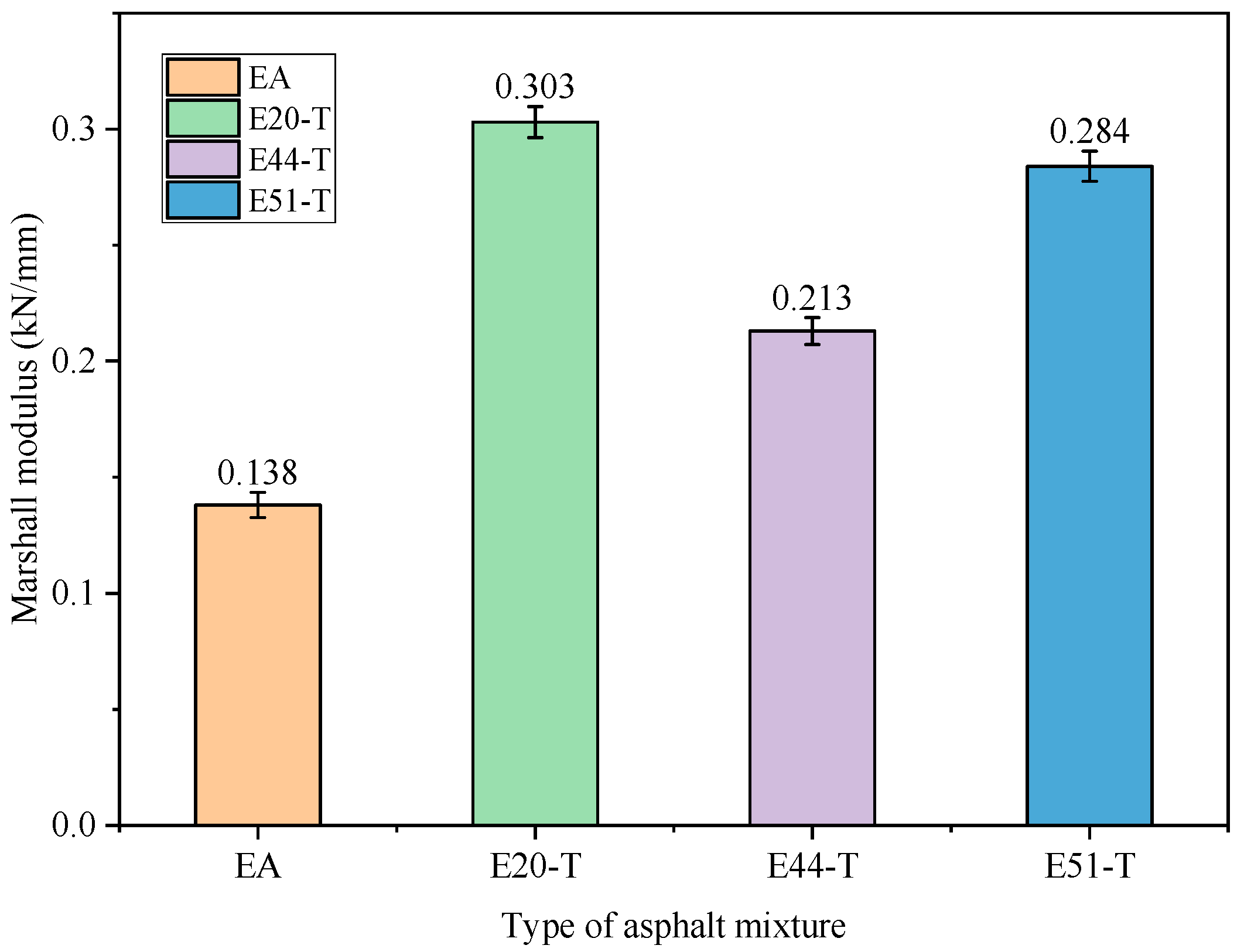
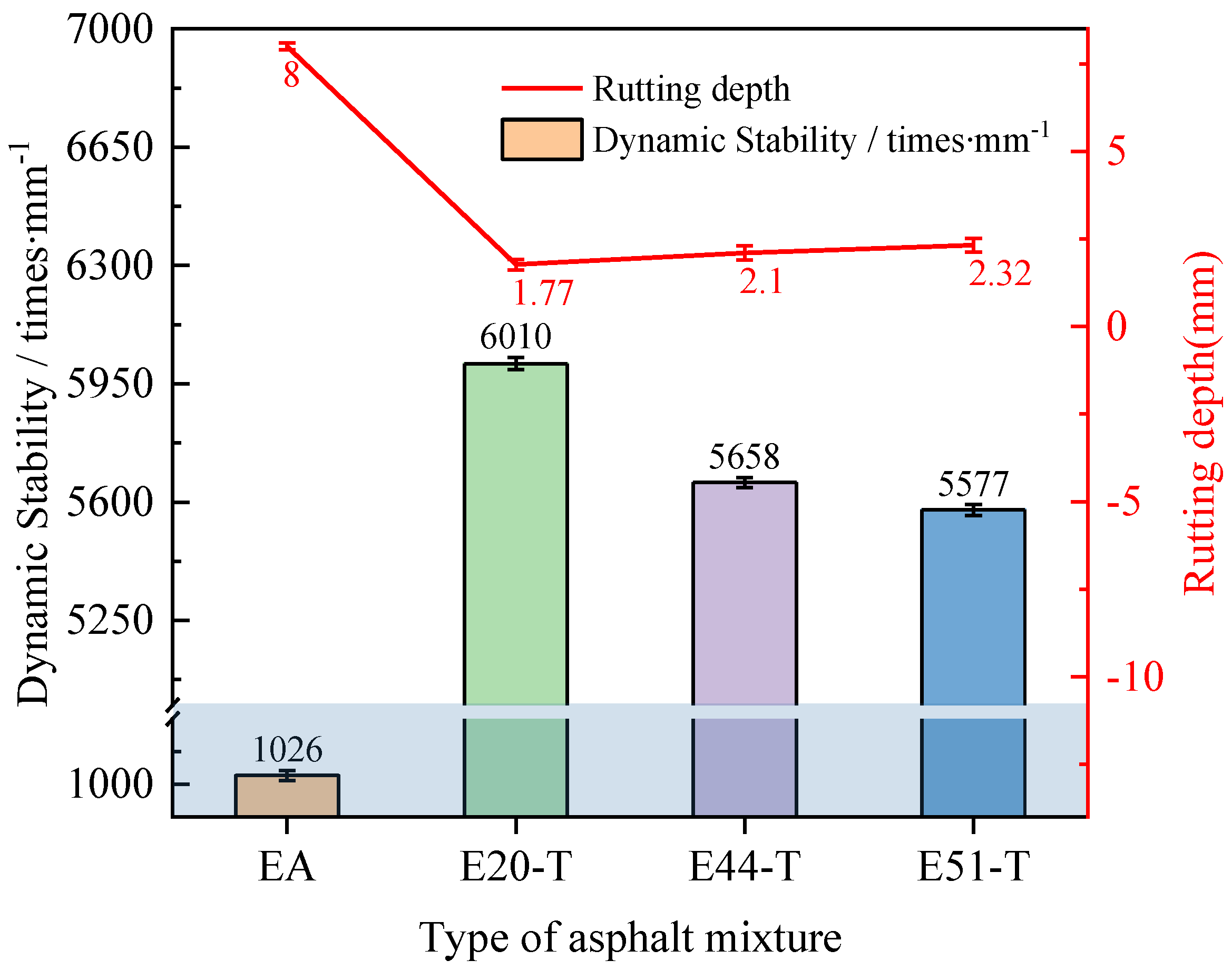




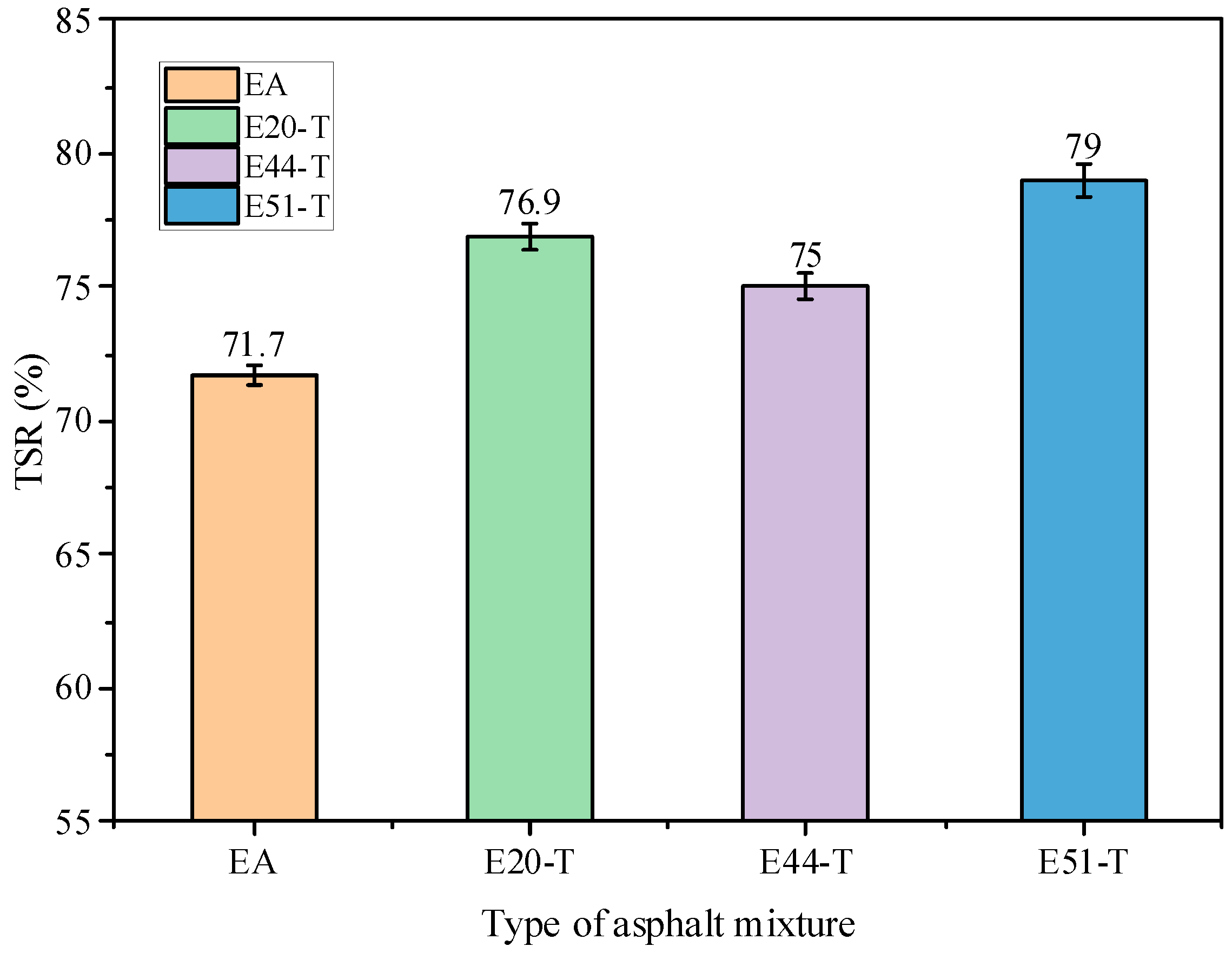
| Property | Unit | Test Results | Specification Requirements | Testing Method |
|---|---|---|---|---|
| Penetration (25 °C, 100 g, 5 s) | 0.1 mm | 69 | 60–80 | ASTM D5 [20] |
| Ductility (15 °C) | cm | 124 | >100 | ASTM D113 [21] |
| Softening point | °C | 46.6 | >46 | ASTM D36 [22] |
| Viscosity (135 °C) | Pa·s | 0.50 | <3 | ASTM D4402 [23] |
| Property | Unit | Test Results | Specification Requirements | Testing Method |
|---|---|---|---|---|
| Particle charge | - | + | + | ASTM D7402 [24] |
| Demulsification speed | - | Slow cracking | Slow cracking | ASTM D244 [25] |
| Residue on sieve (1.18 mm sieve) | % | 0.04 | ≤0.1 | ASTM D6933 [26] |
| Solid content | % | 63 | ≥55 | ASTM D6934 [27] |
| Mixing test with coarse and fine aggregates | - | Uniform | Uniform | |
| Storage stability at room temperature (1 day) | % | 0.55 | ≤1 | ASTM D6930 [28] |
| Storage stability at room temperature (5 days) | % | 3.17 | ≤5 | |
| Evaporation residue penetration (25 °C) | 0.1 mm | 64.2 | 45–150 | ASTM D5 [20] |
| Evaporation residue softening point | °C | 48.5 | - | ASTM D36 [22] |
| Evaporation residue ductility (15 °C) | cm | 80.3 | ≥40 | ASTM D113 [21] |
| Property | Unit | Test Results | ||
|---|---|---|---|---|
| E20 | E44 | E51 | ||
| Appearance | - | Milky white homogeneous liquid | ||
| Epoxy value | eq/100 g | 0.21 | 0.44 | 0.51 |
| Epoxy equivalent | g/mol | 456 | 227 | 196 |
| Solid content | % | 50 ± 2 | ||
| Property | Unit | Test Results | ||
|---|---|---|---|---|
| DETA | 593 | TETA | ||
| Appearance | - | Light yellow transparent liquid | Light-colored transparent liquid | Light yellow viscous liquid |
| Molecular weight | - | 103.17 | 217.13 | 146.23 |
| Amine value | mg KOH/g | 1617.8 | 603.5 | 1498.0 |
| Solid content | % | >99 | >99 | >99 |
| Density | g/cm3 | 0.960 | 0.985 | 0.982 |
| Boiling point | °C | 207 | 170 | 278 |
| Property | Test Results | Specification Requirements | Test Method |
|---|---|---|---|
| Los Angeles wear loss | 17.0% | ≤30% | ASTM C131 [29] |
| Crush value | 19.9% | ≤28% | ASTM C136 [30] |
| Soundness | 4.0% | ≤12% | ASTM C88 [31] |
| Soft stone content | 1.2% | ≤3.0% | ASTM C142 [32] |
| Needle flake content | 9.9% | ≤15% | ASTM D4791 [33] |
| Particle size ≥ 9.5 mm | 10.0% | ≤12% | ASTM D4791 [33] |
| Particle size ≤ 9.5 mm | 11.9% | ≤18% | ASTM D4791 [33] |
| Property | Test Results | Specification Requirements | Test Method |
|---|---|---|---|
| Sludge content (≤0.075 mm) | 1.9% | ≤3% | ASTM C117 [34] |
| Apparent relative density | 2.701 | ≥2.50 | ASTM C128 [35] |
| Sand equivalent | 77.6% | ≥30% | ASTM D2419 [36] |
| Soundness | 5.1% | ≤12% | ASTM C88 [31] |
| Property | Test Results | Specification Requirements | Test Method |
|---|---|---|---|
| Appearance | No clumping | No clumping | - |
| Apparent density | 2810 kg/m3 | ≥2500 kg/m3 | ASTM D854 [37] |
| Hydrophilic coefficient | 0.69 | <1 | ASTM D2419 [36] |
| Moisture content | 0.19% | ≤1% | ASTM D2216 [38] |
| Plasticity index | 2.8% | <4% | ASTM D4318 [39] |
| Property | 10–20 Gears | 5–10 Gears | Stone Chips |
|---|---|---|---|
| Apparent relative density | 2.691 | 2.779 | 2.656 |
| Gross volume relative density | 2.602 | 2.698 | 2.599 |
| Water absorption | 0.29% | 0.70% | 0.50% |
| Aggregate Mass Percentage (%) Passing the Following Sieve Holes (mm) | ||||||||||
|---|---|---|---|---|---|---|---|---|---|---|
| 16 | 13.2 | 9.5 | 4.75 | 2.36 | 1.18 | 0.6 | 0.3 | 0.15 | 0.075 | |
| Upper Limit | 100 | 100 | 85 | 68 | 50 | 38 | 28 | 20 | 15 | 8 |
| Lower limit | 100 | 90 | 68 | 38 | 24 | 15 | 10 | 7 | 5 | 4 |
| Median gradation | 100 | 95 | 76.5 | 53 | 37 | 26.5 | 19 | 13.5 | 10 | 6 |
| Properties | VV | VFA | MS | FL |
|---|---|---|---|---|
| Specification requirements | 4~6% | 65~75% | ≥3 kN | 1.5~4 mm |
| 7.7% | 8.95% | 7.7% | 7.7% | |
| 9.7% | 9.7% | 9.7% | 9.7% |
| Property | EA | E20-T | E44-T | E51-T | Specification Requirements |
|---|---|---|---|---|---|
| 2.02 | 2.24 | 2.39 | 2.12 | / | |
| VV/% | 11.85 | 7.55 | 8.00 | 8.01 | / |
| MS/kN | 4.94 | 6.24 | 5.67 | 6.21 | ≥3 |
| FL/mm | 3.56 | 2.06 | 2.66 | 2.19 | 1.5~4 |
| VMA/% | 22.19 | 19.27 | 21.05 | 20.20 | ≥14 |
| VFA/% | 65.02 | 72.91 | 66.26 | 66.78 | 65~75 |
Disclaimer/Publisher’s Note: The statements, opinions and data contained in all publications are solely those of the individual author(s) and contributor(s) and not of MDPI and/or the editor(s). MDPI and/or the editor(s) disclaim responsibility for any injury to people or property resulting from any ideas, methods, instructions or products referred to in the content. |
© 2024 by the authors. Licensee MDPI, Basel, Switzerland. This article is an open access article distributed under the terms and conditions of the Creative Commons Attribution (CC BY) license (https://creativecommons.org/licenses/by/4.0/).
Share and Cite
Wang, L.; Zhang, Z.; Liu, W.; Wu, M.; Shi, J.; Yan, K. Effects of Epoxy Resin Value on Waterborne-Epoxy-Resin-Modified Emulsified Asphalt Mixture Performance. Appl. Sci. 2024, 14, 1353. https://doi.org/10.3390/app14041353
Wang L, Zhang Z, Liu W, Wu M, Shi J, Yan K. Effects of Epoxy Resin Value on Waterborne-Epoxy-Resin-Modified Emulsified Asphalt Mixture Performance. Applied Sciences. 2024; 14(4):1353. https://doi.org/10.3390/app14041353
Chicago/Turabian StyleWang, Lieguang, Zirui Zhang, Wenyao Liu, Mingfei Wu, Junyi Shi, and Kezhen Yan. 2024. "Effects of Epoxy Resin Value on Waterborne-Epoxy-Resin-Modified Emulsified Asphalt Mixture Performance" Applied Sciences 14, no. 4: 1353. https://doi.org/10.3390/app14041353
APA StyleWang, L., Zhang, Z., Liu, W., Wu, M., Shi, J., & Yan, K. (2024). Effects of Epoxy Resin Value on Waterborne-Epoxy-Resin-Modified Emulsified Asphalt Mixture Performance. Applied Sciences, 14(4), 1353. https://doi.org/10.3390/app14041353








